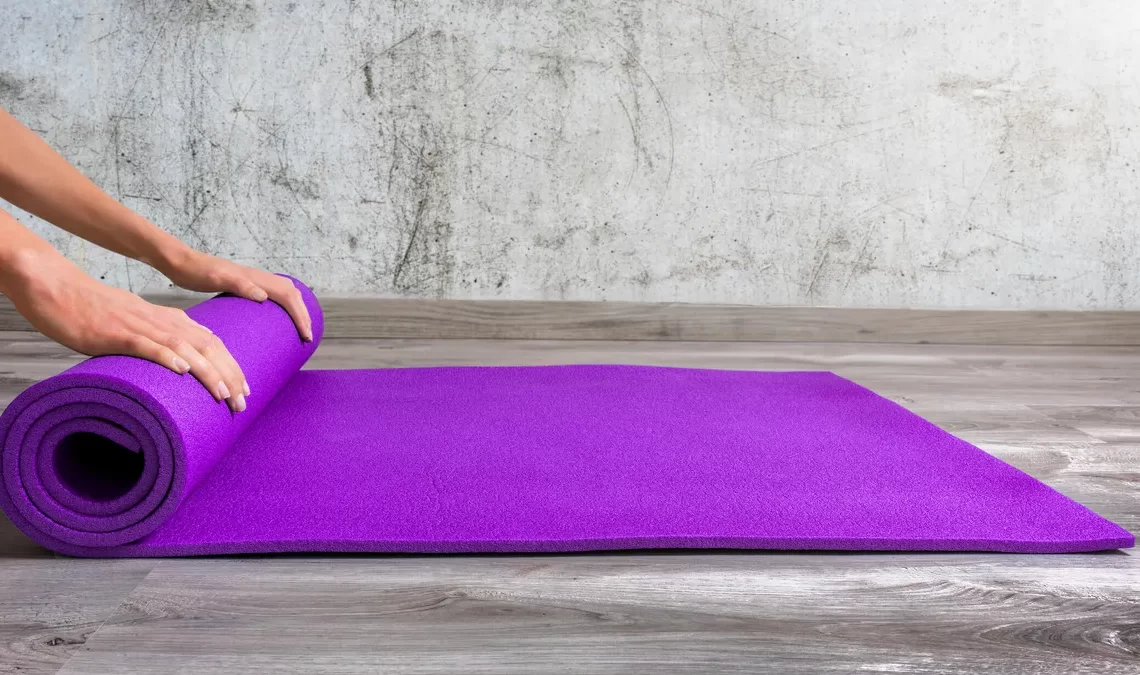
A yoga mat is your personal sanctuary, providing a comfortable and stable foundation for your practice. A non-slip yoga mat is crucial for maintaining balance and stability during various poses, preventing injuries, and fully immersing yourself in the practice. However, due to factors such as low-quality materials, sweat, and dirt buildup, many yoga mats can become slippery over time, diminishing their functionality.
The Causes of a Slippery Yoga Mat
Low-Quality Material
One of the primary reasons for a slippery yoga mat is the use of low-quality materials during manufacturing. These mats may lack the necessary grip, making it challenging to maintain stability during your practice. Investing in a high-quality yoga mat made from non-slip materials such as natural rubber or polyurethane can significantly improve your yoga experience.
Sweat and Moisture
Intense physical activity during yoga can cause sweat to accumulate on the mat, creating a slippery surface. Additionally, moisture from the environment or humid conditions can exacerbate the problem. It’s crucial to address sweat and moisture to prevent your mat from becoming slippery.
Dust and Dirt Buildup
Over time, dust, dirt, and oils from your skin can accumulate on the mat, reducing its grip. Regular cleaning is essential to remove these particles and maintain the traction of your yoga mat.
Improper Cleaning and Maintenance
Improper cleaning and maintenance practices can also contribute to a slippery yoga mat. Using harsh chemicals or abrasive cleaning tools can damage the mat’s surface and affect its grip. It’s important to follow the manufacturer’s guidelines for cleaning and storing your mat properly.
How to Prevent a Slippery Yoga Mat
To prevent your yoga mat from becoming slippery, consider the following measures:
Choose the Right Material
When purchasing a yoga mat, opt for one made from high-quality, non-slip materials. Look for mats specifically designed to provide superior grip and traction. Natural rubber mats or those with a polyurethane surface are excellent choices.
Use a Yoga Towel
Using a yoga towel on top of your mat can enhance grip and absorb sweat during your practice. These towels are designed with anti-slip properties and provide an additional layer of traction.
Clean Your Mat Regularly
Regular cleaning is crucial to maintain the grip of your yoga mat. Use a mild detergent or mat-specific cleaner to remove dirt and sweat buildup. After cleaning, ensure the mat is thoroughly dried before using it again.
Try Mat Grippers or Traction Pads
Mat grippers or traction pads are adhesive-backed sheets that you can apply to the bottom of your yoga mat. These provide additional traction and prevent the mat from sliding on smooth surfaces.
DIY Remedies to Improve Mat Grip
If you’re experiencing a slippery yoga mat and want to explore DIY solutions, here are a few remedies you can try:
Use a Salt Scrub
Create a mixture of salt and water, and scrub it onto the surface of your mat using a cloth. The salt acts as a natural abrasive, helping to remove dirt and enhance grip.
Apply a Vinegar Solution
Mix equal parts of water and white vinegar in a spray bottle. Spray the solution onto your mat, let it sit for a few minutes, and then wipe it off with a clean cloth. Vinegar helps remove oils and residue, improving traction.
Create a Grip-Enhancing Spray
Make a grip-enhancing spray by combining a few drops of essential oil, such as lavender or tea tree oil, with water in a spray bottle. Lightly mist your mat before practice to enhance grip.
Sprinkle Some Baby Powder
If your mat becomes slippery due to sweat, you can sprinkle a small amount of baby powder on the surface. The powder absorbs moisture, providing a temporary grip.
Additional Tips for a Better Yoga Experience
In addition to addressing a slippery yoga mat directly, consider the following tips to enhance your overall yoga practice:
Use Proper Technique and Alignment
Maintaining proper technique and alignment in your yoga poses can help distribute your weight evenly, reducing the risk of slipping. Focus on engaging your core, grounding through your feet, and maintaining a steady posture.
Warm Up Before Practice
Warming up your body before starting your yoga session can increase blood circulation and help reduce excessive sweating, minimizing the chances of a slippery mat. Incorporate dynamic stretches and light movements to prepare your muscles for the practice ahead.
Consider Your Environment
Ensure you have a suitable environment for your yoga practice. Choose a well-ventilated area with appropriate flooring, free from excessive humidity or moisture. This can contribute to a more comfortable and slip-free practice.
Wear Appropriate Clothing
Wearing comfortable and moisture-wicking clothing can help manage sweat during your yoga practice. Opt for fabrics such as cotton or synthetic blends that allow your skin to breathe and reduce the likelihood of a slippery mat.
Conclusion
A slippery yoga mat can be frustrating and disruptive during your practice, but there are effective solutions available. By understanding the causes of a slippery mat and implementing preventive measures, such as choosing the right material, using yoga towels, and regular cleaning, you can enhance the grip and stability of your yoga mat.
Additionally, DIY remedies like salt scrubs, vinegar solutions, grip-enhancing sprays, and baby powder can provide temporary fixes. Remember to incorporate proper technique, and warm-up, and consider your environment and clothing choices to further improve your overall yoga experience.
FAQs
Why is my yoga mat slippery even though it’s new?
New yoga mats often have a protective coating or residue that can make them slippery. Before using a new mat, make sure to clean it thoroughly according to the manufacturer’s instructions.
Can I use a regular towel instead of a yoga towel?
While a regular towel can provide some grip, yoga towels are specifically designed with anti-slip properties and are better suited for yoga practice. They are made to fit the mat perfectly and offer enhanced traction.
How often should I clean my yoga mat?
It’s recommended to clean your yoga mat after every few uses, especially if you sweat heavily during your practice. Regular cleaning helps maintain the mat’s grip and keeps it hygienic.
Will using a grip-enhancing spray damage my mat?
Most grip-enhancing sprays are safe to use on yoga mats, but it’s important to check the instructions and test a small area before applying it to the entire mat. Avoid using sprays that contain harsh chemicals that may damage the mat’s surface.
Can I practice yoga without a mat?
While a yoga mat provides stability and cushioning, it’s possible to practice yoga without one. However, practicing on a non-slip surface is essential to prevent injuries and maintain proper alignment. Consider using a yoga towel or practicing on a carpeted area if you don’t have a mat.

